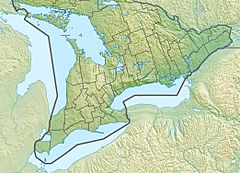Sauble River (Ontario) facts for kids
Quick facts for kids Sauble River |
|
|---|---|
|
Location of the mouth of the Sauble River in southern Ontario
|
|
| Country | Canada |
| Province | Ontario |
| Region | Southwestern Ontario |
| Counties |
|
| Physical characteristics | |
| Main source | Unnamed pond Chatsworth, Grey County 305 m (1,001 ft) 44°21′08″N 80°58′55″W / 44.35222°N 80.98194°W |
| River mouth | Lake Huron Sauble Beach, South Bruce Peninsula, Bruce County 176 m (577 ft) 44°39′42″N 81°16′45″W / 44.66167°N 81.27917°W |
| Basin features | |
| River system | Lake Huron drainage basin |
| Tributaries |
|
The Sauble River is a river in Bruce County and Grey County in southwestern Ontario, Canada. It flows from its starting point in the township of Chatsworth all the way to Lake Huron. The river meets Lake Huron at the community of Sauble Beach.
Contents
What's in a Name?
The name "Sauble River" comes from the French language. Early French explorers called it Rivière aux Saubles. This means "sandy river." On maps, it was known as River aux Saubles until 1881. After that, its name officially became the Sauble River. In the past, a sawmill and a power plant were built along the river.
The River's Journey
The Sauble River begins its journey in Grey County. It starts from a small pond in the township of Chatsworth. This spot is located between the communities of Desboro and Mooresburg.
The river first flows north, then turns west. Along the way, it is joined by smaller streams. These include Grimston Creek and Keady Creek. The river then flows along the edge of the municipality of Arran–Elderslie in Bruce County. It passes near the community of Grimston.
Next, the Sauble River enters the municipality of Arran–Elderslie. It reaches the community of Tara. Here, another stream called Tara Creek flows into it. The river continues to head north. It is joined by Arkwright Creek. It then flows through the community of Allenford.
Finally, the river reaches the municipality of South Bruce Peninsula. It turns northeast and is joined by Park Head Creek. West of Hepworth, the river turns west again. It takes in Spring Creek and the Rankin River. The Sauble River then flows over the beautiful Sauble Falls. Its long journey ends when it flows into Lake Huron at Sauble Beach.
Life in and Around the River
Sauble Falls Provincial Park is a special place located right at the Sauble Falls. This park protects the natural beauty of the area.
The Sauble River is home to many different types of fish. You can find fish like brown trout, chinook salmon, and coho salmon. Other fish species include largemouth bass, northern pike, and rainbow trout. Walleye and panfish also live in the river.
The area around the river is important for its health. The southern part of the river's basin has a fair amount of forest cover. This means 15% to 20% of the land is covered by trees. The trees along the riverbanks, called the riparian zone, also have some forest cover. The water quality in this upper part of the river is fair. It also has good numbers of tiny creatures living on the riverbed, called benthic species.
The northern (lower) part of the river's basin is even healthier. It has excellent forest cover, with more than 35% of the land covered by trees. The forest along the riverbanks is also fair, with 25% to 50% tree cover. The water chemistry in this section is excellent. It also has good numbers of benthic species, showing a healthy river environment.
Streams Joining the Sauble River
Many smaller streams flow into the Sauble River along its path. These are called tributaries.
- Rankin River (joins from the right side)
- Spring Creek (joins from the right side)
- Park Head Creek (joins from the right side)
- Arkwright Creek (joins from the left side)
- Tara Creek (joins from the left side)
- Keady Creek (joins from the right side)
- Grimston Creek (joins from the left side)
Towns Along the Sauble River
Several communities are located along the Sauble River.
- Sauble Beach
- Allenford
- Tara
- Grimston


